
|
John A. Weeks III
Friday, January 9, 2026, 3:50:54 PM CST |
|||
| Home | Photo Tours | Rail Fan | 12 Easy Steps |
| Aviation | Spacecraft | Highways & Bridges | About The Author |

|
|
|||||||||||||||||
STS-117 AtlantisSpace Shuttle Launch
|
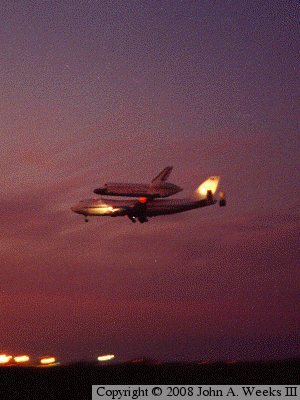
|
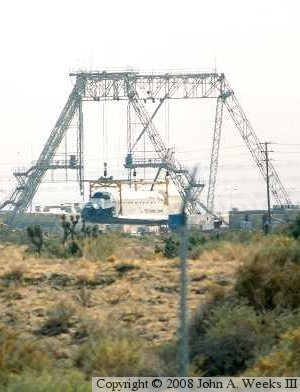
|
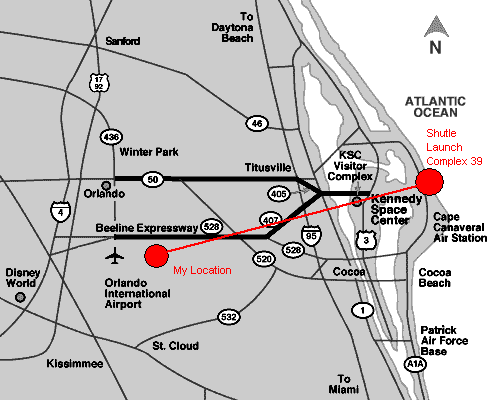
I ended up being 39 miles from the launch site. This compares to being about 11 miles away when I viewed STS-121 in July of 2006. To make the best of it, I planned to try to capture the large arc that the shuttle makes as it lifts off into low-Earth orbit.
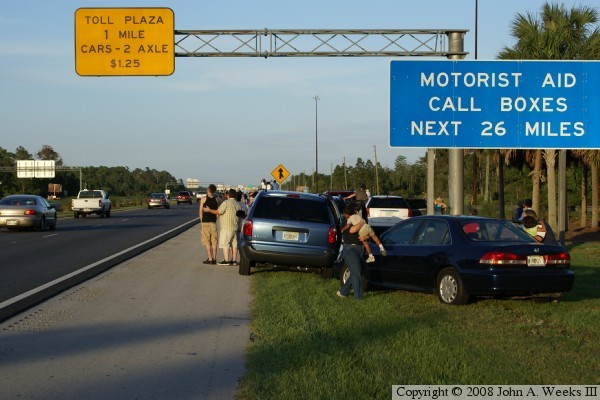
I was hoping to get a few miles east of the toll booth, and then stopping on an overpass. As it was, I pulled over here with just 3 minutes to spare, not wanting to get stuck in the line at the toll plaza and missing the launch. The eastbound lanes of the Bea Line Freeway had cars parked two and three deep. Some folks stopped under the FL-417 freeway overpasses, and climbed the bridges to get a better view.
There is an excellent FM radio station out of Titusville that runs wall to wall shuttle coverage on launch days. They ran through both the count down sequence and first few minutes of launch so people would know what to expect. Then, after the 9 minute hold expired, they ran the NASA public affairs commentary loop, adding in notes as needed to explain things. This was a major help to me so I could judge how long to keep driving, and where to park when the time came.
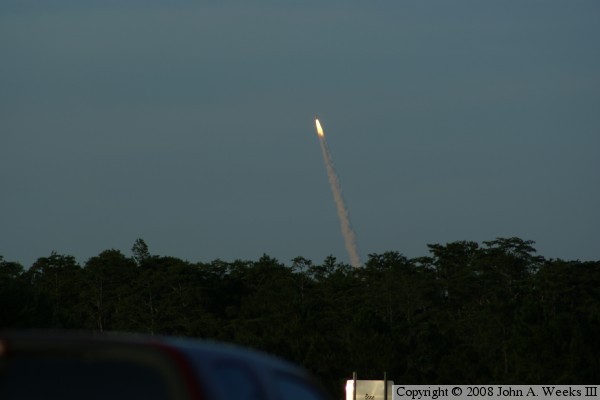
While it was relatively late in the day, it wasn't as dark as this photo would seem to suggest. The very bright light from the solid rocket boosters tricks the electronics in the camera into making the background darker than it otherwise should be. A good photographer would know how to adjust shutter and aperture to compensate. I, on the other hand, just push the button and hope for the best. This was my first photos with a new Sony Alpha A100, and I didn't want to risk making a setting mistake and ruin all the photos. At any rate, the exhaust flame from the shuttle stack is extremely bright, even at a distance of 40 miles.
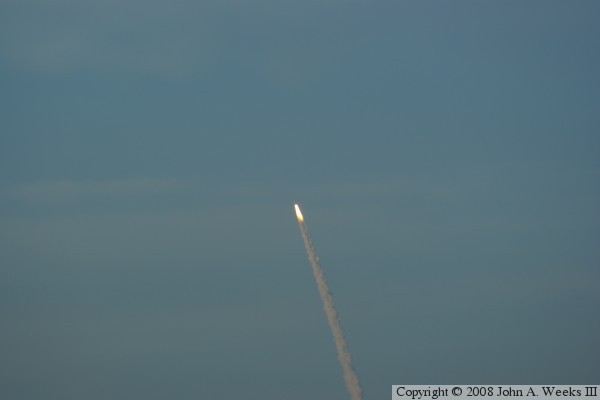
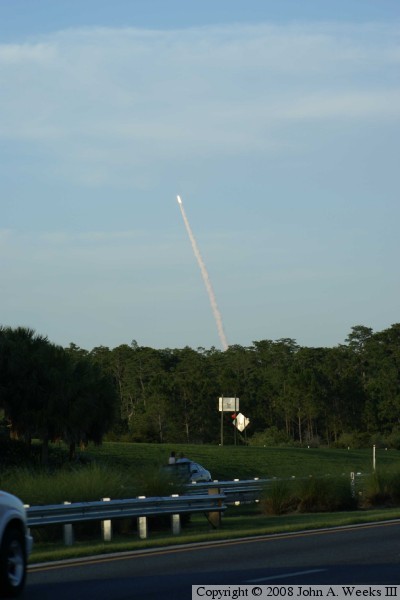
Notice the layer of light clouds over the launch site. The shuttle has punched about halfway through that layer of clouds.
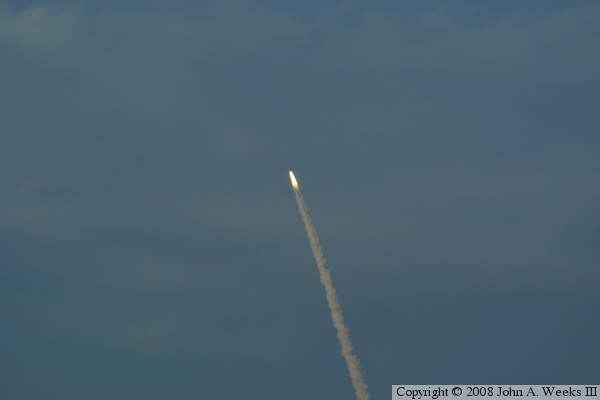
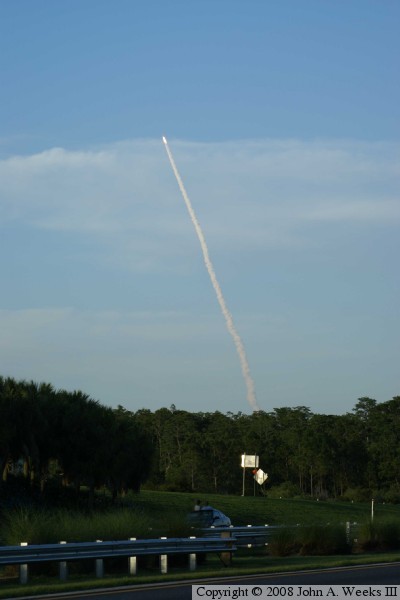
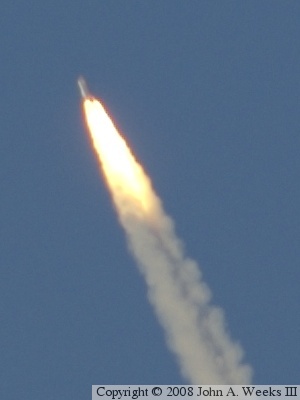
This photo is a very impressive example of what a modern SLR camera can do. Keep in mind that this is a hand-held photo, I was 39 miles from the launch pad, the vehicle is now 10 miles in altitude and 6 miles northeast of the pad, and it is moving at 1000 miles per hour. While I haven't done the math, I would have to guess that the shuttle was at least 50 miles away.

Notice here that the clouds are at the very bottom of the photo. It is interesting to compare the locations of the clouds here with the previous three photos.
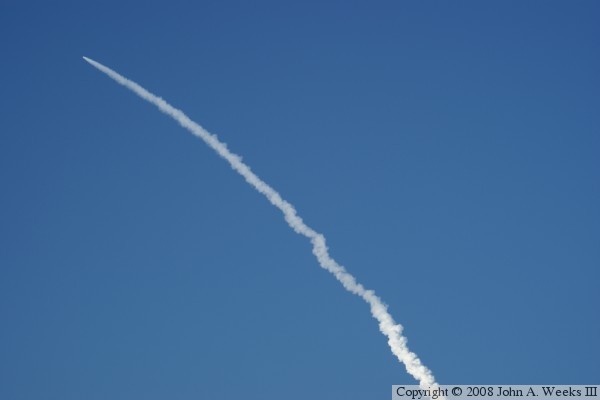
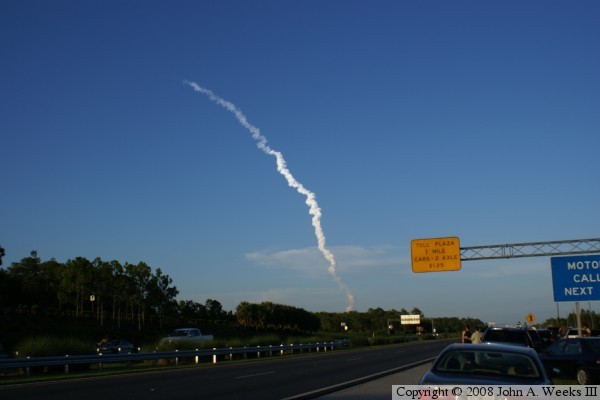

|
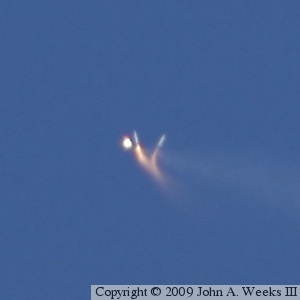
|

|
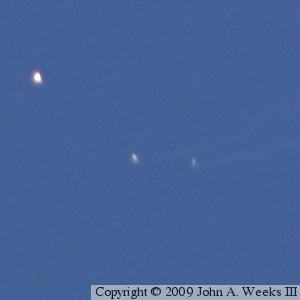
|
The first photo shows the flame being very small. The puffs of smoke going wide are from the explosive bolts that attach the SRBs to the stack. The second photo shows the SRBs after separation, but before they have fully burned out. At this stage, they still produce a lot of flame, but relatively little thrust.
The third photo shows the SRBs continuing to follow the shuttle in a ballistic arc. In general, the SRBs separate from the stack an an altitude of 30 miles, but momentum continues their flight for another minute until they reach an altitude of about 45 miles. The fourth photo shows the SRBs after they have reached maximum altitude and have started to fall to the ocean. The boosters will splash down near Jacksonville, Florida, where they will be recovered by the cutters Liberty Star and Freedom Star. The SRBs are then towed back to KSC, where they will be disassembled and sent by train to Utah to be refilled.
I was astounded that I captured a photo of the solid rocket boosters after separation when I watched Discovery fly in July of 2006. A key goal for this trip was to get a set of photos that captured the sequence of events at SRB separation. I used a 450mm APO F5 lens to capture the SRB separation. These photos are taken hand-held, but the CCD in the camera is gyro stabilized to keep the images from blurring.



I was booked on Delta from Minneapolis to Atlanta, then Freedom Airlines from Atlanta to Orlando. As I was walking out of the house, I got a call from Delta saying that my 2nd leg was canceled, and I could take a flight about 6 hours later. That simply wouldn't do. Travelocity was no help because they don't show flights that leave within 4 hours. So my only choice was to book a replacement flight from Atlanta to Orlando, this time, on AirTran. That increased the risk since these flights were not booked as a connection, so I would be out of luck if I missed the second flight.
I went to the Delta counter in Minneapolis to check in, only to find that my Minneapolis flight was now canceled. Delta again wanted to put me on a very late flight. After some aggressive negotiation, they agreed to put me on a Northwest flight at no charge.
As the Northwest flight was about to board, they announced that due to weather, they had to load extra fuel. That means that only 83 of the 100 passengers with tickets would get to fly. Sorting out that mess made the flight late, but at least, I had a seat. Then, as the aircraft was about to leave the gate, the crew discovered a problem with an emergency exit. A team of mechanics had to come out to the airplane and fix a door latch. Now seriously late, the pilot announced that we would have to wait another 20 minutes because we missed our landing window into Atlanta.
We finally did get into the air. Once airborne, we had to fly east nearly to the east coast to fly around a major storm-front. As we neared Atlanta, we were put into a hold, and made a few circles around Gainesville before they allowed us into Atlanta.
With all these delays, once I landed in Atlanta, I had exactly 9 minutes before my AirTran flight departed. Since you are supposed to check in 10 minutes before the flight, they could have denied me boarding even if I did get there within 9 minutes. A few people on the Northwest flight allowed me to bypass them and get off of the NWA plane rather quickly. I then located the flight board, and found that my flight was in Terminal C, and I was in D. So, I had to take the train. I arrived at the AirTran gate with about 4 minutes to spare. I apologized to the gate agent for being late, and explained that my inbound flight was seriously delayed. She issued me a boarding ticket with a smile. As I walked towards the jetway, I noticed that I was in seat 3F, which was first class. The gate agent gave me a free upgrade.
The AirTran flight was programmed to leave at 3:17PM. The shuttle was set for 7:38PM. That is 4 hours and 21 minutes. The flight is 1 hour 1 minute, plus maybe 20 minutes in the airport at each end. This gives me a margin of 2 hours and 40 minutes from Orlando to Titusville, a trip that can be made in 50 minutes. I was on track. I had dodged all the cancellations and weather, so I thought.
At 3:20, the crew announced that we had to hold because a few other connecting flights were late inbound. That cost 20 minutes. Next, when we pulled back from the gate, the pilot announced that we were number 18 for take off. 18 planes times 3 to 4 minutes per plane means that we were stuck at least another hour. But I still had a margin of time to make it to Titusville. As we reached number 3 in line, the pilot came on the radio and announced that a thunderstorm had developed over the end of the departure runway, and that controllers had instituted a ground stop. The airport was now closed. If the storm would have moved quickly, I still might have made it. But the storm went on and on. The crew broke out the drinks, then the drink carts and serviced the entire plane. We finally departed at 5:50PM.
A 737-800 has a lot of power. Once we did take off from Atlanta, the pilot put the pedal to the metal. I have never seen a plane climb to 10,000 feet so quickly. And rather than avoiding storms, the pilot simply aimed towards Orlando and punched through the weather debris. The 1 hour 1 minute flight was done in less than 50 minutes, so we landed at Orlando at 6:40PM. I thought I had caught a small break. I was now looking at getting a rental car and maybe getting as far as US-1 along the coast.
Alas, what air traffic control gives you, air traffic control takes away. Our gate was not available, so the pilot had to taxi three-fourths of the way around the airport to get to the new gate. That took 15 minutes of taxi time. I did get right off the plane, and made tracks towards the terminal. I had reserved a car from a company that was at the main terminal just for this reason (so I wouldn't burn time riding shuttles). I was out of the airport in the rental car at 7:10PM. I had 28 minutes, and I was 38 miles from the coast. The Bea Line expressway is marked 70 MPH, and going 80, I could make up a few minutes, and still salvage this fiasco.
Again, it was not to be. I merged onto the Bea Line going east, only to find bumper to bumper traffic going about 20 miles per hour. That was my last chance to get an up front view for this launch, unless, of course, they had to scrub. I turned on the radio, only to hear that the weather was getting better and better, and they were almost certainly going to launch. I really wanted to get an exit or two east of the Bea Line toll booth. But traffic was backed so badly up that I had to make a decision about 7:30PM. It looked like if I tried to go through the toll booth, I might get stuck in line, and miss the launch. So, I pulled off of the highway about a mile short of the toll booth on the east side of the FL-417 interchange. This put me 39.25 miles from the launch pad, and 28 miles from where I wanted to be on the edge of the Indian River in downtown Titusville.
Despite being a few miles short, I did have a great view of the launch, and I am excited by the quality of the SRB photos. It was also nice to make the scene and talk with other people who were equally excited by the space program. Next up is Endeavour, STS-118, scheduled for August 9, 2007. I am not going to fly the same day for that launch.
|
|
Authored by John A. Weeks III, Copyright © 1996—2016, all rights reserved. For further information, contact: john@johnweeks.com
|